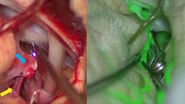In this video, Chief Microsurgeon Professor Küntscher and his team perform a radial forearm free flap phalloplasty and use ICG fluorescence imaging to show the blood flow in the whole flap from the anastomosis to the distal end of the penoid. Professor Küntscher demonstrates the additional assurance the GLOW800 AR provides to check blood flow in addition to usual clinical signs.
Key Learnings
- Supports critical decision-making in the operating room with enhanced blood flow inspection using built-in ICG fluorescence imaging, in real time in the operating room.
- Improves operating teamwork by projecting the microscope image to the screen so each team member can follow each surgical step.
- Streamlines theatre ergonomics allowing the surgical team to move easily around the numerous surgical sites. Also, the light weight makes it easy to place the microscope over the surgical site and the long-reaching arm with a wide arc of motion reaches a broad area of the operating room.
- Heightens optical precision with the two beams that automatically select the optimal focal length.
Ensuring correct blood flow in the graft at each step is critical to avoiding post-operative anastomotic revision. Anastomotic problems, leading to revision occur in the first 48 hours and have been reported to occur in 11% of cases [3].
Watch the clinical case & experience radial forearm free flap phalloplasty
Professor Küntscher and his team use their Leica surgical microscope with built-in GLOW800 AR and FL800 fluorescence during gender-reaffirming phalloplasty.
During this 1.5-hour clinical case video, Professor Küntscher presents the worldwide premiere of GLOW800 AR in gender-reaffirming surgery. This clinical case shows radial forearm free flap harvest, tube-in-tube shaft construction, phalloplasty anastomosis and illustrates how GLOW800 AR detects blood flow, supporting critical decision-making in the operating room.
Benefits of surgical microscopy with augmented reality in radial free flap phalloplasty
In radial free flap phalloplasty, the outstanding optics in the M530 OHX surgical microscope with combined enhanced depth of field and high resolution provides the whole operating team with an optimal view of the surgical site. Also, the long-reaching overhead stand and smooth, precise movement allow the surgeon to position the microscope easily above any surgical site, even on the far edge of the operating room.
The built-in FL800 intra-operative fluorescence-aided video angiography with ICG (indocyanine green) with the recent, GLOW800 AR option allows the whole operating team to confirm correct blood flow in the graft before closing.
Watch the radial forearm free flap phalloplasty with prelaminated urethra clinical case and see how GLOW800 AR detects graft blood flow, supporting critical decision-making in the operating room [4].
About Professor Küntscher

Professor Markus Küntscher, is the Chief Physician in the Department of Plastic and Hand Surgery, at the Evangelische Elisabeth Klink, Director of the Reconstructive Breast Centre in Berlin, and Senior Lecturer at the Heidelberg University. He is specialised in plastic reconstructive, aesthetic and hand surgery. Professor Küntscher studied medicine at the University of Heidelberg, and went on to specialise in plastic surgery at the BG Trauma Centre Ludwigshafen, the largest plastic surgery unit in Europe. Afterwards, he moved back to Berlin to become the Vice President at the Centre for Serious Burn Injuries Unfallkrankenhaus.
Disclaimer: The statements of the healthcare professional in this video reflect only his opinion and personal experience. His statements do not necessarily reflect the opinion of any institution with whom he is affiliated.










